#Powered Roller Conveyor Systems
Explore tagged Tumblr posts
Text
#Powered Roller Conveyor Systems#powered roller conveyor#powered flexible conveyor#flexible powered roller conveyor#motorized roller conveyor manufacturers#powered roller conveyor manufacturers#heavy duty powered roller conveyor
0 notes
Text
Roller Conveyor in Faridabad | Vashnavi Conveyor Industry
Vashnavi Conveyor Industry offers high-quality roller conveyors in Faridabad for smooth and efficient material handling across various industrial sectors. Whether you need gravity or powered roller conveyors, our systems are engineered for durability, easy installation, and seamless movement of goods in warehouses, production lines, and distribution centers.
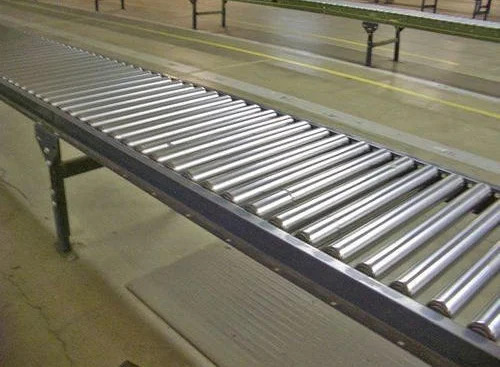
#Roller conveyor Faridabad#conveyor system manufacturer#Vashnavi Conveyor#gravity roller conveyor#powered roller conveyor#material handling equipment#industrial conveyors
0 notes
Text
24V DC Power Roller Conveyor Manufacturer, Supplier in Ahmedabad, India
Conveline Systems Pvt Ltd is a trusted name among powered roller conveyor manufacturers in Ahmedabad, Gujarat. We specialize in providing high-quality 24V DC powered conveyor rollers designed for efficiency, durability, and reliable performance. Our range of powered conveyor systems is suitable for various industries, including manufacturing, warehousing, logistics, and more.
Why Choose Powered Roller Conveyor Systems?
Powered roller conveyor systems are essential for streamlining material handling and transportation in industries. These systems use powered conveyor rollers to move goods smoothly and efficiently. Whether it’s lightweight items or heavy-duty applications, our solutions cater to all load capacities.
Our 24V DC power roller conveyors offer the following advantages:
Energy Efficiency: Low power consumption for cost-effective operation.
Quiet Operation: Minimal noise, ensuring a comfortable work environment.
Customizable Designs: Tailored to specific operational needs.
Durability: Built to withstand heavy-duty applications.
Heavy Duty Powered Roller Conveyors
We provide heavy-duty powered roller conveyors for applications requiring high strength and reliability. These conveyors are ideal for handling large and heavy goods, ensuring smooth and safe transportation.
Affordable Powered Roller Conveyor Price List
At Conveline Systems, we understand the importance of cost efficiency. We offer competitive pricing for our powered roller conveyors without compromising on quality. Our powered roller conveyor price list is transparent and designed to suit different budgets and requirements.
Applications of Powered Conveyor Systems
Our powered roller conveyor systems are used in industries such as:
Automotive manufacturing
Packaging and distribution
Food processing
E-commerce and warehousing
Why Conveline Systems?
Expertise: Leading powered conveyor roller manufacturer in India.
Quality: Superior materials and advanced manufacturing techniques.
Customization: Solutions tailored to your specific needs.
Support: Dedicated after-sales service and technical assistance.
For premium 24V DC powered conveyor rollers and reliable powered roller conveyor systems, contact Conveline Systems Pvt Ltd today. We ensure high performance, durability, and affordability for all your material handling requirements.
For More Information
Block No. 472, Tajpur Road, Changodar Ahmedabad- 382213, Gujarat, India
7486023925
#powered roller#power roller conveyor#Powered conveyor roller#powered roller conveyor system#powered conveyor systems#24v dc powered conveyor roller#24v dc power roller conveyor#heavy duty powered roller conveyor#powered roller conveyor price list#powered roller conveyor manufacturers
0 notes
Text
Northtown Maintenance-of-Way, part 3
For the final part of this mini-series, I'll be focusing on a few miscellaneous, specialized machines used in the track maintenance process. Each one's role can be done by other, less specialized machines, but it would be a good deal harder.

This is a Mineral Products Inc. Multi-Purpose Machine. It's a mechanical jack of all trades, used for everything from trenching to blowing snow off of tracks. Its most common use is as a 'yard cleaner': the big broom mounted to the front picks up material between the rails and loads it onto a conveyor belt, which can dump it off to the side or into a towed railcar. Another popular job is snow removal: the broom is exchanged for an auger system, and the rear-most conveyor can be replaced with an impeller fan and chute. MPI's website says the machine can move 2000 pounds of snow per hour, and the blower can fling it up to 150 feet away from the tracks. Because it's not limited to just the rails, it can also be used on yard roads & parking lots. Other attachments include a trencher, air blower, rotary broom, and a hydraulic arm which can be fitted with its own range of attachments. I'm starting to sound like a shill here... but it is a pretty cool piece of kit.

The next piece of machinery is Herzog's ACT, or Automated Conveyor Train. It's a special set of cars which uses a conveyor system and swinging boom to "precisely" drop ballast where it's needed. The yellow thing seen above is the train's main power unit. I don't know if it uses hydraulic or electric motors, but this car powers them. Each train set has up to 30 cars, which are just high-side gondolas with conveyors in the bottom. Each car has its own conveyor, which dumps into the next car's conveyor through a small hopper.
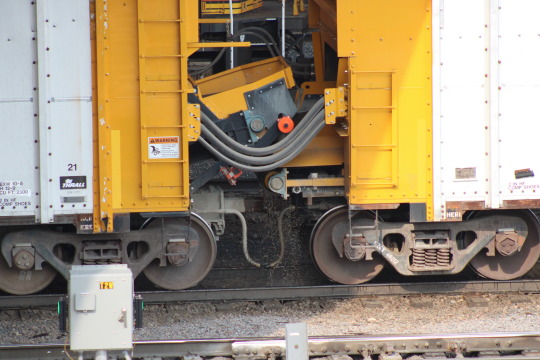
A closer look at the connection between cars. I don't know if the water is from recent rains or the train's dust suppression system.
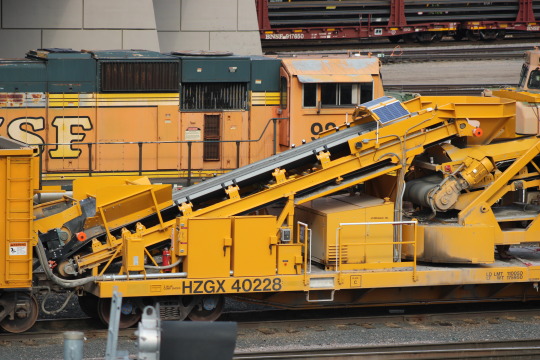

And here's the 'front' of the train, which is really the end. It features the operator's cabin and the most important bit, the unloading arm. It can move ballast 50 feet from the center of the tracks, according to Herzog's website. Conveyor trains like this one are mostly used for filling in washed-out track beds, but can also strategically place piles of ballast for future projects. As of writing this post, the control car is still less than a year old. It really is the cutting edge of ballast-dropping technology!

The last machine is another Herzog product: the creatively-named Rail Unloading Machine. It looks complicated, but is actually quite simple. A crane arm feeds sticks of continuously-welded rail (CWR) into a roller system, which feeds it forward (backwards, really) through two clamps and onto the ground.
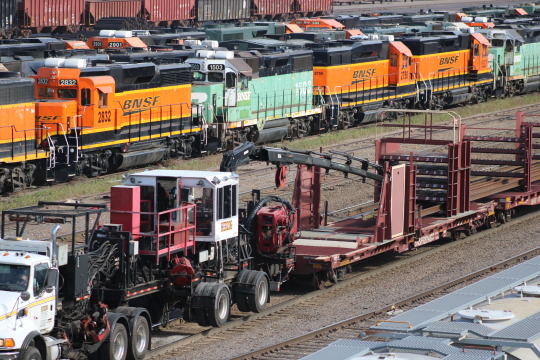
A view of the other side. Same deal, but all folded up. Check out the flex on that arm!

5 notes
·
View notes
Text

Keep your line moving smoothly #AluminumExtrusion #Power conveyor frames & roller #system that are #seamless integration Ideal for high-#speed high-#volume #operation in #logistics & #packaging Streamline your #process with custom fit #profiles https://beyondlineals.com https://www.instagram.com/beyondlineals/ https://x.com/Beyondlineals https://www.facebook.com/beyondlineals/ https://www.youtube.com/@BeyondLineals https://www.threads.net/@beyondlineals https://in.pinterest.com/Beyondlineals/ #DigitalMarketing #windowsanddoors #Profile #manufacturing #Innovation #cnc #AluminumProfile #AluminumWindows #AluminumDoors #Tools #Engineering📐 #HVAC👷
2 notes
·
View notes
Text

O-Belt Driven Conveyor Rollers!
Upgrade your conveying systems with our O-Belt Driven Conveyor Rollers! Smooth, efficient, and built to last. Keep things moving seamlessly. Explore our O-Belt Driven Conveyor Rollers catalog.
2 notes
·
View notes
Text
Why Pillow Block Bearings Are the Backbone of Heavy-Duty Equipment?
When it comes to powering large-scale operations, selecting the right components is key to long-term performance and cost efficiency. Among the unsung heroes in heavy-duty setups are pillow block bearings, which play a pivotal role in supporting rotating shafts and maintaining alignment under high-stress conditions. Whether used in construction, mining, or material handling, these bearing units offer consistent stability and minimal maintenance, making them a top choice across sectors.

Unlike standard bearing options, pillow blocks come as a complete unit—housing and bearing included. This makes them ideal for quick installation and replacement without the need for specialized tools or extensive downtime. In operations where every minute of productivity counts, this feature alone adds measurable value.
The Importance of Pillow Blocks in High-Load Applications
Heavy machinery such as crushers, conveyors, mixers, and pulverizers experience constant vibration, high pressure, and extreme environmental factors. This is where bearings for heavy machinery must be not only durable but also able to absorb shocks and reduce friction without compromising on alignment. Pillow block bearings excel in this role, offering a rigid structure that can withstand axial and radial loads effectively.
When integrated into systems exposed to outdoor conditions, pillow blocks also perform well in resisting contamination from dust, moisture, and chemicals. Their sealed or shielded designs ensure long-lasting functionality with minimal lubrication needs, which is crucial in remote or hard-to-access areas of operation.
Selecting the Right Bearings for Your Operation
The right bearing doesn’t just ensure function—it boosts the efficiency and life span of your equipment. That’s why it’s important to source from a trusted industrial bearings supplier known for dependable components. Buyers looking for quality bearings online should seek out suppliers with a diverse inventory and proven customer service.
A comprehensive roller bearings catalog can make it easier to compare specifications and find the exact fit for your machinery. From tapered and cylindrical options to needle designs, there’s a solution for virtually every application. For those in need of long-term durability and performance, investing in high-quality bearing products pays off in reduced breakdowns and lower maintenance costs.
Conclusion
The industrial world leans heavily on reliability—and pillow block bearings provide just that. Their unique design, durability, and ease of integration make them essential in supporting the mechanical foundation of heavy-duty equipment. Whether replacing worn parts or upgrading systems, incorporating pillow blocks is a strategic move for sustained operational success.
0 notes
Text
The Versatility and Value of Steel Pipes and Tubes in Modern Industry
Steel pipes and tubes form the backbone of infrastructure, manufacturing, and industrial applications around the globe. From foundational construction to cutting-edge machinery, these components are vital for efficient and safe operations. In this blog, we explore various types of steel pipes and tubes, their applications, and how they add value across different industries.

1. Pile Tubes and Piling Pipes: Strength from the Ground Up Pile tubes or piling pipes are used as deep foundations for buildings, bridges, and other large-scale structures. These steel pipes bear the load of entire infrastructures, transferring weight to deeper, more stable soil layers. Their strength, resistance to pressure, and durability make them an essential component in civil engineering.
2. Precision Pipes and Tubes: Engineered for Accuracy Precision pipes and ERW precision tubes (Electric Resistance Welded) are manufactured with strict tolerances and fine finishes. These are commonly used in the automotive, aerospace, and machinery industries where high-performance components are required. Precision tubes ensure consistent dimensions, making them ideal for hydraulic and mechanical applications.
3. GP Pipes, GP Tubes, and GP Square Pipe: Corrosion-Resistant Utility GP (Galvanized Plain) pipes and tubes are zinc-coated, which offers excellent corrosion resistance. These are widely used in construction, fabrication, and fencing. GP square pipe varieties are ideal for structural applications due to their uniform shape and strength. GP pipe price per kg remains affordable, making it a preferred choice for budget-conscious projects.
4. API and ASTM Pipes: Meeting Global Standards API pipe and ASTM pipe types are built to meet international quality standards. API pipes are typically used in oil and gas transport, while ASTM pipes cater to industries like power plants and chemical processing. These pipes undergo rigorous testing to ensure reliability in high-pressure and high-temperature environments.
5. Rolling Pipe, Roller Tubes, and Steel Tube Rollers Rolling pipes are widely used in conveyor systems and material handling setups. Roller tubes and steel tube rollers ensure smooth transport of goods in logistics, textile, packaging, and manufacturing industries. Their smooth operation and wear resistance make them essential for high-efficiency systems.
6. Corten Steel Tubes and Pipes: Built for the Outdoors Corten steel pipe and corten tube products are designed to withstand weathering without the need for painting. They develop a protective layer of rust that enhances their appearance while protecting the inner metal. These are commonly used in architecture, landscaping, and outdoor installations.
7. Furniture Pipes and Square Tube Furniture: Functional Aesthetics Furniture pipes, including square tube furniture frames, provide modern design solutions. Their sleek appearance, strength, and ease of welding make them suitable for home, office, and industrial furniture. Steel-based furniture is not only stylish but also durable.
8. Boom Pipes and Boom Tubes: Heavy-Duty Applications Boom pipe or boom tube types are used in concrete pumping machines and other high-pressure construction equipment. These are designed to withstand heavy loads and repeated impacts, making them ideal for rugged applications.
9. Steel Conduit Pipes: Safety in Wiring Steel conduit pipes are essential for housing electrical wiring in buildings. They protect cables from mechanical damage and environmental factors, ensuring long-term safety and performance in residential, commercial, and industrial structures.
10. CRCA Pipe and APH Tubes: Specialized Engineering CRCA pipe (Cold Rolled Close Annealed) is used in lightweight fabrication, automotive components, and general engineering applications. These pipes offer good surface finish and formability.
APH tubes (Air Pre-Heater tubes) are typically used in thermal power plants and boilers to improve energy efficiency by recovering waste heat from flue gases.
11. Rolled Steel Tube and Rollertube: Motion and Strength Combined Rolled steel tube and Rollertube products are tailored for applications that require smooth rolling and high structural integrity. These are often found in logistics systems, automated lines, and material handling equipment.
Conclusion: Choosing the Right Steel Product Whether you're sourcing materials for large-scale infrastructure or looking to design industrial furniture, choosing the right steel pipe or tube is essential. Products like GP pipe, API pipe, corten steel tubes, and precision pipes serve different functions but all contribute to the strength and functionality of the final application.
AST Pipes offers a wide variety of these products at competitive prices, along with expert guidance to help you select the right material for your project. Explore our full product range and discover why our steel solutions are trusted across India.
For more information, visit AST Pipes
#gp pipe#precision tubes#ERW pipe#corten steel tube#furniture pipe#boom pipe#CRCA pipe#ASTM pipe#steel tube roller#piling pipe#rolled steel tube#GP pipe price per kg
0 notes
Text
Boost Efficiency and Throughput with Powered Roller Conveyor Systems
Introduction
In today's fast-paced industrial and logistics environments, efficiency and automation are no longer optional—they’re essential. One of the most effective ways to streamline material handling and improve throughput is with a powered roller conveyor system. Whether in a warehouse, distribution center, or manufacturing facility, powered roller conveyors provide seamless, automated movement of goods with minimal manual intervention.
In this blog, we’ll explore what powered roller conveyor systems are, how they work, their key benefits, and the industries that can benefit the most from their implementation.
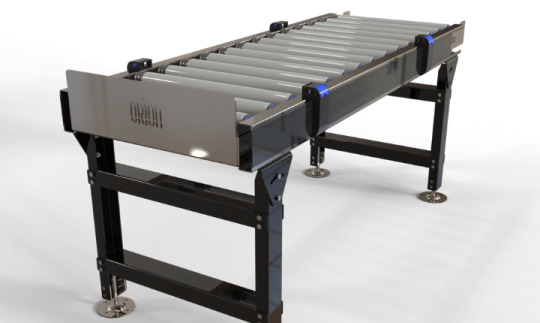
What Is a Powered Roller Conveyor System?
A powered roller conveyor uses motors to drive rollers and move items along the conveyor line. Unlike gravity conveyors, which rely on slope and gravity, powered systems are ideal for controlled and efficient movement of goods, especially over long distances or around curves and inclines.
They come in various configurations—line shaft, belt-driven, chain-driven, and motorized roller (MDR)—each suited to different applications depending on load size, speed, and operational environment.
Key Features of Powered Roller Conveyors
Motorized Control: Enables consistent speed and direction for smooth product flow.
Modular Design: Easy to expand, reconfigure, or integrate with automated systems.
Heavy-Duty Load Handling: Suitable for moving small parcels to heavy pallets.
Low Maintenance: Modern systems are built for durability and energy efficiency.
Custom Integration: Can be equipped with sensors, sorters, and automated pick-and-place systems.
Benefits of Powered Roller Conveyor Systems
1. Increased Throughput
Automated movement of goods minimizes delays and improves flow, resulting in higher productivity and faster order fulfillment.
2. Improved Safety
Reduces manual handling, lowering the risk of workplace injuries. Operators can focus on supervision rather than physical transport.
3. Energy Efficiency
Many modern systems use energy-efficient motorized rollers (MDRs) that consume less power and operate only when items are detected on the rollers.
4. Low Downtime
Robust design and smart diagnostics reduce unexpected breakdowns and enable easy maintenance.
5. Scalability
From small operations to large warehouses, powered roller conveyors can scale to meet growing demands.
Common Applications
E-commerce Fulfillment Centers
Automotive Assembly Lines
Food & Beverage Packaging Plants
Pharmaceutical Distribution
Airport Baggage Handling
Third-Party Logistics (3PL)
Is a Powered Roller Conveyor Right for Your Business?
If your operations involve frequent, repetitive movement of items—especially in high volumes—a powered roller conveyor system can dramatically enhance efficiency. It's also ideal if you're planning to integrate automation or robotics into your material handling strategy.
Conclusion
As industries continue to adopt smart technologies, the demand for reliable, scalable, and efficient conveyor systems will only increase. Powered roller conveyors are a smart investment for businesses seeking to optimize their logistics, reduce manual labor, and future-proof their operations.
Whether you’re upgrading your facility or designing a new one, powered roller conveyors can be a game-changer.
0 notes
Text
#Flexible Powered Roller Conveyor System#conveyx powered flex conveyor#flexible powered roller conveyor#Powered Flexible conveyor design#Powered Flexible Conveyor
0 notes
Text
Roller Conveyor Manufacturer in Faridabad | Vashnavi Conveyor Industry
Vashnavi Conveyor Industry is a leading roller conveyor manufacturer in Faridabad, offering high-performance and durable roller conveyor systems for industrial automation and material handling needs. Our precision-engineered conveyors are ideal for manufacturing units, warehouses, and packaging industries. Get reliable and customizable solutions at competitive prices.
#Roller conveyor Faridabad#conveyor manufacturer Faridabad#Vashnavi Conveyor#gravity roller conveyor#powered roller conveyor#industrial conveyors#material handling systems
0 notes
Text

Conveline Rollers is a leading industrial conveyor roller manufacturer based in India, renowned for its high-quality products and innovative solutions in material handling systems. Established with a commitment to excellence, Conveline Rollers specializes in designing and producing a wide range of conveyor rollers that cater to diverse industrial applications. The company's product line includes gravity rollers, motorized rollers, heavy-duty rollers, and specialized rollers tailored to specific customer needs. Each roller is meticulously engineered using state-of-the-art technology and premium-grade materials to ensure durability, reliability, and efficient performance in demanding environments. For more ifo visit website: https://www.convelinerollers.com/power-roller-conveyor
#Industrial Conveyor Roller Manufacturer in india#powered roller conveyor system#Industrial Conveyor Roller Manufacturer#powered roller conveyor manufacturers#24v dc power roller conveyor
0 notes
Text
Automated Material Handling Solutions for Warehouses in UK
Warehousing is changing fast in the UK. Rising demands, tight deadlines, and labour shortages make automation more essential than ever. Automated material handling solutions for warehouses in UK are no longer a luxury. They are becoming the backbone of modern supply chains. These systems offer speed, accuracy, and reduced human error. From conveyors and robots to AGVs and AS/RS, automation is transforming how goods move in and out of UK warehouses.

Automated Material Handling Solutions for Warehouses in UK Let's explore how these solutions work, their benefits, and what makes them vital for warehouse operations across the UK.
Importance of Automated Material Handling Solutions for Warehouses in UK
Manual processes are slow and error-prone. In large warehouses, this leads to delays, bottlenecks, and damaged goods. Automated material handling solutions for warehouses in UK help solve these problems. They move materials quickly, with precision. They reduce the need for manual labour. This boosts efficiency, especially in sectors like e-commerce, retail, and third-party logistics. Automation also helps warehouses meet growing expectations. Customers want faster deliveries. Retailers want lower costs. Automation makes both possible.
Components of Automated Material Handling Solutions for Warehouses in UK
Conveyor Systems Conveyors transport goods across various zones of the warehouse. They come in different types—roller, belt, and chain conveyors. In UK warehouses, powered conveyors are often used in pick-and-pack areas. They are fast and ideal for repetitive movement of items. Automated Guided Vehicles (AGVs) AGVs are driverless transport systems. They follow pre-set paths or use sensors to navigate. They are useful in large UK distribution centres. They reduce walking time for staff. They are also safer, as they avoid collisions and follow strict routes. Automated Storage and Retrieval Systems (AS/RS) AS/RS systems are robotic arms or shuttles that place or pick goods from storage racks. They use vertical space better than manual systems. In urban UK warehouses with limited space, AS/RS help save floor area. They also allow 24/7 operation. Robotic Picking Systems These systems use robotic arms with grippers or suction cups. They pick items from bins and place them into totes or boxes. They often work with AI to recognize items. In the UK, where online shopping is massive, robotic pickers help with fast order fulfillment. Warehouse Management Systems (WMS) A WMS controls all automation in the warehouse. It manages inventory, coordinates machines, and tracks goods. It connects with ERP systems for better control. WMS also helps reduce human oversight by automating tasks like stock counts and reorder alerts.#AutomatedMaterialHandling, #WarehouseAutomationUK, #LogisticsSolutions, #MaterialHandlingEquipment, #SmartWarehousing, #AutomationInLogistics, #UKWarehouses, #IndustrialAutomation, #WarehouseEfficiency, #RoboticsInWarehousing, #SupplyChainInnovation, #AutomationTechnology, #WarehouseSolutions, #HandlingSystems, #FutureOfWarehousing Read the full article
#AutomationSystems#IndustrialTechnology#Logistics#MaterialHandling#OperationalEfficiency#Robotics#SmartLogistics#SupplyChain#UKWarehousing#WarehouseAutomation
0 notes
Video
youtube
Slant Bed vs. Flat Bed CNC Lathe: Which One is Perfect for You#SlantBedL...
Are you trying to decide between a Slant Bed CNC Lathe and a Flat Bed CNC Lathe for your machining needs?
In this video, we break down the ultimate comparison between these two CNC lathe designs—from performance and applications to costs and maintenance.
🎯 What You'll Learn in This Video:
Key differences between Slant Bed and Flat Bed CNC Lathes.
Which lathe suits high-speed production and which one is ideal for heavy-duty machining.
Cost analysis and ROI insights for smarter investments.
Expert tips to help you make the right choice for your business.
💡 Highlights:
✔️ Slant Bed Lathes are compact, fast, and precise, perfect for industries like automotive and aerospace.
✔️ Flat Bed Lathes are sturdy, durable, and powerful, ideal for oil, gas, and construction sectors.
👉 Read the full blog for more details:
Click here Video Outline Introduction Welcome to the video! Quick overview of why choosing the right CNC lathe design is critical for your business.
Mention the two CNC lathe types we’ll be comparing: Slant Bed and Flat Bed. Part 1: What Is a CNC Lathe? Brief explanation of CNC lathes and their importance in modern machining. Examples of industries where CNC lathes are indispensable (e.g., aerospace, automotive, oil, gas).
Key features of CNC lathes, such as precision, repeatability, and automation options. Part 2: Design Differences Slant Bed CNC Lathes: Angled bed design (30–45°) for better chip evacuation.
Compact footprint and ergonomic layout. Multi-tool setups with turret systems (e.g., 12-station turrets).
Flat Bed CNC Lathes: Horizontal bed for stability and heavy-duty machining. Larger swing diameters and higher load capacities (up to 5 tons).
Requires manual chip removal or conveyor systems.
Part 3: Performance Metrics Speed and Efficiency: Slant Bed: Up to 4,500 RPM, reducing cycle times by 15–20%.
Flat Bed: Lower speed (up to 2,500 RPM) but higher torque for heavy cuts. Precision and Accuracy: Both achieve tolerances of ±0.002 mm.
Slant Bed: Superior coolant flow reduces thermal expansion by 10%. Flat Bed: Excellent precision under heavy loads but requires frequent chip management.
Part 4: Applications Slant Bed Lathes: High-volume production, ideal for precision parts like pistons and aerospace fittings. Automation-friendly with bar feeders and robots.
Flat Bed Lathes: Heavy-duty machining, perfect for large workpieces like pump shafts and rollers. Popular in industries like oil, gas, and construction. Part 5: Cost and ROI Analysis Initial investment:
Slant Bed: $5,000–$50,000.
Flat Bed: $5,000–$40,000.
Operational Costs: Slant Bed: Lower energy consumption and maintenance costs. Flat Bed: Higher durability for long-term heavy-duty use.
ROI: Slant Bed recovers costs faster in high-production environments (3–4 years). Flat Bed suits long-term heavy-duty projects (4–6 years). Part 6: Final Thoughts and Recommendations Recap the pros and cons of each CNC lathe type.
Advice on choosing the right lathe based on: Workpiece size. Production volume. Industry requirements. Encourage viewers to explore Haishu Machinery’s blog for more details and insights.
#CNCLathe #SlantBedLathe #FlatBedLathe #MachiningSolutions #PrecisionMachining #HaishuMachinery #MetalMachining #CNCManufacturing #Engineering
#youtube#CNCLathe#SlantBedLathe#FlatBedLathe#MachiningSolutions#PrecisionMachining#HaishuMachinery#MetalMachining#CNCManufacturing#Engineering
1 note
·
View note
Text
Field Guide: Neutralising a Remote-Controlled Armoured Bulldozer
0. Operating Principles
Optical/LIDAR sensors are vulnerable to particulate clouds.
Tracked vehicles lose traction in deep mud and can stall if foreign objects jam the rollers.
Most heavy machines contain service panels with high-current fuses or emergency disconnects.
Remote operators usually follow a “fault → safe shutdown” protocol to protect the drivetrain.
The tactics below layer these weaknesses so the machine enters its own safety shutdown, minimising direct confrontation.
1. Dust & Smoke Screen
Goal: Blind cameras/LIDAR for 60–90 s.
Materials • 20–30 kg powdered chalk, lime, or cement • One or more steel drums half-filled with waste motor oil or diesel • Rags and a road flare or torch
Procedure
Place drums up-wind of the expected approach.
Ignite rags, then tip drums to spill burning oil—produces dense black smoke.
Simultaneously throw powdered chalk into the plume; a leaf-blower or shovel flick works.
Maintain the cloud until primary actions (sections 3 & 4) are complete.
Notes • Fine dust (>5 µm) scatters IR and visible light far better than coarse sand. • Avoid magnesium-based powders (risk of flash fire).
2. Mud Trap
Goal: Slow advance and keep the vehicle over the cable trap.
Materials • Broken fire-hydrant, stand-pipe, or high-flow garden hose • Shovels to churn soil • Optional: plastic sheeting under topsoil to prevent drainage
Procedure
Flood a 6–8 m stretch of roadway to a depth of 10–15 cm.
Rake and shovel the surface into slurry; remove large rubble that might act as traction.
Begin flooding 10 min before engagement so ground stays saturated.
3. Track-Entanglement Cable
Goal: Jam rollers and trigger “stall/obstruction” interlock.
Materials • 25–30 m of 10 mm steel tow-cable • 2 heavy ratchet straps or chain shackles (≥5 t rating) • Abrasion guard: 0.5 m of hose or conveyor belt • Manual winch—bicycle, crank, or lever type • Two solid anchor points: lamp post, tree stump, buried truck axle, etc.
Assembly
Strap/weld strap A to anchor 1.
Strap B to anchor 2 on the opposite side of roadway.
Feed cable through abrasion guard where it will meet the track.
Connect cable ends to winch and ratchet fully tight; height should equal the first roller centre (~25–35 cm on most dozers).
Coil 1 m of slack in the cable’s centre so, if it breaks, energy dissipates in the coil rather than a straight whip.
Execution • Initiate once dust screen is up. • As the vehicle drives onto the cable, grousers pull it between pads; tension locks rollers in <1 s. • Even if anchors deform, temporary stall is enough for step 4.
Safety • Stand clear 5 m to the side; wear eye protection. • Rehearse height with a 200 kg wheelbarrow to confirm engagement.
4. Service-Panel Electrical Disable
Goal: Cut main power and radio link.
Recon • Typical panel location: mid-chassis, left flank. • Secured by 4 captive 6 mm hex bolts; inside are 2 × 500 A fuses and diagnostic port.
Materials • 6 mm hex key on lanyard • Copper shorting bar (25 mm × 10 mm × 2 mm) • Heat-resistant gloves and face covering
Steps (≤90 s total)
Approach under dust/smoke cover on the blind side.
Remove bolts; store in pocket.
Bridge both fuse terminals with the copper bar; hold 2 s until breaker trips.
Withdraw bar, reseat panel, finger-tighten bolts (hides tampering).
Evacuate into smoke before IR cameras recalibrate.
Outcome • Control computer loses power → actuators and comms drop. • Remote operator receives “fatal fault / loss of comms” and system enters lockdown.
5. Synchronisation & Timeline
T-00 s Ignite oil drums, throw powdered chalk T + 30 s Vehicle noses into mud, cable is live T + 40–45 s Cable jams rollers; dozer stalls T + 45 s Begin panel unbolting T + 90 s Main fuses shorted; machine powers off T + 120 s All teams clear area
6. Contingencies
• If cable snaps: retreat behind solid cover; do not attempt second deployment. • If smoke dissipates early: pause panel breach—optics may reacquire targets. • If operator switches to reverse: mud plus partial jam often throws tracks; objective still met.
7. Legal & Ethical Warning
The information above is presented purely as an academic exploration of vulnerabilities in autonomous or remotely operated construction equipment. Actual implementation could be illegal, dangerous, and life-threatening. Always consult local laws and safety professionals before conducting any mechanical intervention.
0 notes